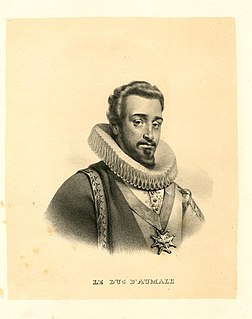Related Research Articles
The County of Aumale, later elevated to a duchy, was a medieval fief in Normandy. It was disputed between England and France during parts of the Hundred Years' War.

René II was Count of Vaudémont from 1470, Duke of Lorraine from 1473, and Duke of Bar from 1483 to 1508. He claimed the crown of the Kingdom of Naples and the County of Provence as the Duke of Calabria 1480–1493 and as King of Naples and Jerusalem 1493–1508. He succeeded his uncle John of Vaudémont as Count of Harcourt in 1473, exchanging it for the county of Aumale in 1495. He succeeded as Count of Guise in 1504.

The House of Lorraine originated as a cadet branch of the House of Metz. It inherited the Duchy of Lorraine in 1473 after the death without a male heir of Nicholas I, Duke of Lorraine. By the marriage of Francis of Lorraine to Maria Theresa of Austria in 1736, and with the success in the ensuing War of the Austrian Succession (1740–1748), the House of Lorraine was joined to the House of Habsburg and became known as the House of Habsburg‑Lorraine. Francis, his sons Joseph II and Leopold II, and his grandson Francis II were the last four Holy Roman Emperors from 1745 until the dissolution of the empire in 1806. The House of Habsburg-Lorraine inherited the Habsburg Empire, ruling the Austrian Empire and then Austria-Hungary until the dissolution of the monarchy in 1918.

Claude de Lorraine, duc de Guise was a French aristocrat and general. He became the first Duke of Guise in 1528.
Count of Guise and Duke of Guise were titles in the French nobility.

Charles of Guise, duc d'Aumale was the son of Claude, Duke of Aumale and Louise de Brézé.

Antoine of Vaudémont was Count of Vaudémont and Sieur de Joinville from 1418 to 1458. By marriage, he was also Count of Harcourt, Count of Aumale, and Baron of Elbeuf from 1452 to 1458.
Jean VII d'Harcourt was a French nobleman. He was Count of Harcourt, Count of Aumale, Viscount of Châtellerault, and Seigneur of Mézières, of Elbeuf, of Lillebone, of La Saussaye etc.

Marie of Harcourt was Countess of Aumale and Baroness of Elbeuf from 1452 to 1476.
Marie d'Alençon was a French noblewoman, a Princess of the Blood, and the wife of John VII of Harcourt, Count of Harcourt and of Aumale, Viscount of Châtellerault, Baron of Elbeuf, of Mézières, of Lillebone, of La Saussaye.
When the Viking chieftain Rollo obtained via the Treaty of Saint-Clair-sur-Epte the territories which would later make up Normandy, he distributed them as estates among his main supporters. Among these lands were the seigneurie of Harcourt, near Brionne, and the county of Pont-Audemer, both of which Rollo granted to Bernard the Dane, ancestor of the lords (seigneurs) of Harcourt. The first to use Harcourt as a name, however, was Anquetil d'Harcourt at the start of the 11th century.
John VI of Harcourt was a count of Harcourt. He was son of John V of Harcourt and Blanche of Ponthieu who was the sister of Jeanne of Ponthieu.

Frederick (Ferry) II of Lorraine-Vaudémont, was Count of Vaudémont and Lord of Joinville from 1458 to 1470. He was son of Antoine of Lorraine, Count of Vaudémont and Lord of Joinville and Marie of Harcourt, Countess of Harcourt and Aumale, as well as Baroness of Elbeuf. He is sometimes numbered Frederick V by continuity with the Dukes of Lorraine.
John of Lorraine-Vaudémont was a younger son of Antoine of Lorraine, Count of Vaudémont and Marie of Harcourt. He was Count of Harcourt and Count of Aumale, as well as Baron of Elbeuf.

Charles III was the third Duke of Elbeuf and member of the House of Lorraine. He succeeded his father Charles II, Duke of Elbeuf, to the Duchy-Peerage of Elbeuf. His mother was an illegitimate daughter of Henry IV of France and Gabrielle d'Estrées. He was also a Peer of France as well as titular Duke of Guise, Count of Harcourt, Lillebonne and Rieux.
François Marie de Lorraine was a French nobleman and member of the House of Lorraine. He was known as the prince de Lillebonne. He was also the Duke of Joyeuse.

François Louis de Lorraine was a member of the House of Lorraine. He was Count of Harcourt. He was also the Count of Rieux, Rochefort and Montlaur. He was also Marquis of Maubec as well as the Baron of Aubenas.

The title Count of Vaudémont was granted to Gérard 1st of Vaudémont in 1070, after he supported the succession of his brother, Theodoric II, Duke of Lorraine to the Duchy of Lorraine. Counts of Vaudémont served as vassals of the Dukes of Lorraine. After 1473 the title was held by the Duke of Lorraine and was bestowed on younger sons of the Duke. It was later restyled "Prince of Vaudémont".
References
- ↑ Alexandre Guilmeth (1849). Notice historique sur la ville et les environs d'Elbeuf. A. Le Brument. pp. 48–118. Retrieved 6 December 2020.
- ↑ Louis Moreri (1732). H-ME. chez Jacques Vincent. p. 661. Retrieved 6 December 2020.
- ↑ François Isidore LICQUET (1831). Rouen. Précis de son histoire, son commerce, ... ses monumens ... Suivi de notices sur Dieppe Elbeuf, Le Havre ... Deuxième édition. p. 347. Retrieved 6 December 2020.